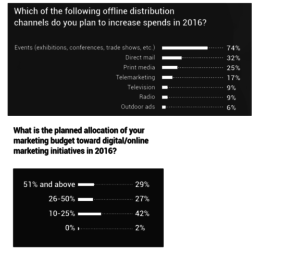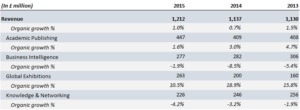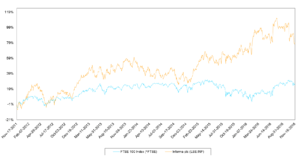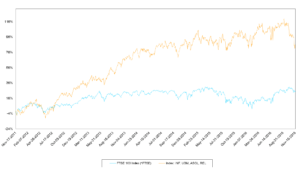The value of face-to-face in a digital world

In a world where a higher proportion of our daily interactions happen online, making the effort to build face-to-face relationships with customers and suppliers seems to be an increasingly valuable investment. Companies that have recognised and acted upon this trend are reaping the benefits.
The world is flat. That is how New York Times reporter Thomas Friedman described the way in which the technological revolution is creating an increasingly level global economic playing field by allowing people around the world to communicate, collaborate and compete (it is also the title of the best seller that he published in 2005)1.
The advent of digital technologies has been, and continues to be, a vital element of this revolution, and the speed at which it is happening is somewhat astonishing. According to ITU2, from 2005 to 2015 the number of mobile phone subscriptions in the world increased from 34 to 99 per 100 people, that is a 191% increase; 46 out of 100 people now own a computer compared to just 26 in 2005, 74% more; and 49 out of 100 have access to the internet at home compared to 18 10 years ago, +166%!3 And this tendency is far from over. Gartner forecasts that by 2020 there will be 21 billion “things” connected to the internet, up 225% from 6.4 billion today4.
This digital transformation is having a huge impact on our lives. From healthcare to transportation, everything around us seems to be changing as the world becomes “flatter” and the concept of the internet of things develops. But in certain industries the consequences of this revolution – and the business opportunities that are being generated thereof – are perhaps less obvious.
One such industry is media, in particular, B2B marketing.
The shift to digital is no doubt happening here too. A recent survey conducted among senior B2B marketing professionals from companies across a range of product categories, found that 77% of respondents identified digital marketing (through a website, email, SEO, social media, blogs etc.) as a high priority for them, largely at the expense of offline channels which were only described as high priority by 23%5. There is, however, one notable exception to this trend: the business of events.
This traditional offline channel, which includes exhibitions, trade shows, festivals and conferences, far from falling out of favour, seems to have become increasingly relevant. The same survey concluded that 74% of respondents planned to increase their marketing spend on events in 2016, which coupled with the fact that only 29% will allocate over 51% of their marketing budget to digital channels6, leads me to believe that a significant portion of companies’ marketing spend is being funneled towards these events.
Why is this seemingly old-fashioned and cumbersome channel growing in popularity when every other trend – even logic! – appears to point to digital as the new, most effective way of communicating and connecting with customers? The answer probably lies in the value of the face-to-face interactions that take place at these events. In an increasingly digitized world, where a higher proportion of the tasks that we perform at our jobs are shifting to online, meeting customers and suppliers in person and building “non-virtual” business relationships, is becoming a rare and ever-more-valuable investment.
Some companies have noticed this trend and are building strong business models around it. One example is Informa Plc. – a UK-listed company focused on business intelligence services, academic publishing and… events. Informa (as well as providing other services) organises more than 170 exhibitions and 2000 other events all over the world, covering topics that range from Real Estate to the Internet of Things, and makes money mainly by charging exhibitors and attendees a fee.
Over the past few years, Informa has been investing heavily in the sector: in 2013 it acquired Agrishow Brazil and Fanexpo Canada Events; in 2014 Hanley Wood Exhibitions as well as three other events; in 2015 Megaconvention and Dwell on Design – the largest design event in the US –; and, notably, a couple of weeks ago Informa acquired Penton – the leading independent US Exhibitions and Professional Information Services group – for $1.6bn, which will add 30 exhibitions to its portfolio7.
But growth in Informa’s events business has not just been M&A-driven, in fact, its exhibitions division – and only this division – has shown consistent double-digit organic growth over the past 3 years8.
However, the extent to which the value of face-to-face interactions and the popularity of events is increasing, is perhaps most clearly highlighted by Informa’s recent share price performance.
And even more so by the average performance of companies competing in the events space.
Considering the above, if you believe a company’s share price accurately reflects investors’ expectations around its future, it is probably fair to say that betting on events and face-to-face interactions becoming more valuable, has thus far garnered considerable support in the market.
So while the world may well be getting flatter as a result of the widespread shift to digital technologies, in some respects, it is just as round as it has always been. If not rounder.
(Words: 800)
****
1 Friedman, Thomas L., The World is Flat (New York, Picador / Farrar, Straus and Giroux, 2005).
2 ITU is the United Nations’ specialized agency for information and communication technologies.
3 ITU World Telecommunication/ICT Indicators database, accessed November 2016.
4 “Gartner Says 6.4 Billion Connected “Things” Will Be in Use in 2016, Up 30 Percent From 2015”, Gartner Inc. press release, 10th November 2015, http://www.gartner.com/newsroom/id/3165317, accessed November 2016.
5 Nimish Vohra and Arunh Krishnan, “State of B2B Marketing 2016”, Regalix (January 2016), http://www.regalix.com/by_regalix/research/reports/state-of-b2b-marketing-2016/, accessed November 2016.
6 Ibid.
7 “Informa completes £1.2bn acquisition of Penton”, Informa Plc. press release (2nd November 2016).
8 Informa Plc., 2015 Annual Report.







Interesting perspective on human interactions. Indeed more and more data can flow through optical fiber pipeline but it does not mean that face to face hands on experience sharing becomes less relevant. It seems that the digital comes as an extra layer that is less relevant without the human interaction.
For instance, this could be the reason why start ups are created and thriving in an open-space 24/7 pizza-eating together experience.
Two views of the future world collide:
– Real human interaction prevails: We share, store, create digital content like never before but real human interaction remains the panacea. Trust, creativity and engagement could not be matched by synthetic link.
– The signal replaces the real interaction: Insurance becomes very expensive in a 140 year life expectancy world. People switch on their VR headset with 5 sense connectivity and we meet in a binary but rich world. The science fiction has described this many times (e.g. Surrogates).
Personally, I share the view that human interaction should remain relevant. But who knows? As Stephen Hawking (2016 Oxford Union talk) prophesies mankind may have only 1,000 years left. I hope he is equally wrong as the doctors who predicted he would not survive two years in 1963.
If this insight of real interaction proves to be true, then the hubs will become more and more valuable. Go long events, NYC, SF, London, TED, Singapore and all the nods.
Jose, I found this super fascinating, and something I think about often. In addition to B2B marketing, live experiences have become much more meaningful for consumer-facing industries. For example, in the music industry, average $$ spent per person per year in the US has decreased from ~$75 around 2000 to ~$20-25 more recently. Total revenue from music sales has decreased significantly from $19Bn in 1999 to $8Bn in 2009, but stablised somewhat over the past 5 years. However, concert revenue has increased by 33% between 2011 and 2015 across the industry – people are going to concerts! [1]
Additionally, as purchasing becomes more commoditized, many retailers are thinking about how to make their stores more experiential. Sonos [2], the internet-connected speaker company, has a store in Soho that has listening rooms, so customers can test out different combinations of their speakers. Pirch [3], a home appliances and home goods retailer, has a store with several rooms that feel like a person’s home – you can take a cooking class there, get a cup of coffee, or even test our a shower. Also, Nike does a ton of in-person run clubs and smaller races.
I think the best companies will recognize the importance of experiences and am excited to see whats to come.
[1] http://www.wsj.com/articles/music-industry-sees-growth-in-concert-revenue-1474250642
[2] http://www.theverge.com/2016/7/12/12157512/sonos-nyc-first-retail-store-photos
[3] http://www.bizjournals.com/newyork/news/2016/05/18/luxury-home-retailer-pirch-to-open-n-y-c-flagship.html
I agree face-to-face interactions will remain important to build businesses and establish relationships. I considered writing my post about the trend against these in pharma. Novartis developed an online conference broadcaster service to enable more doctors around the world to participate in medical conferences. This does not only allow broader participation, but also reduces costs for the pharma company and avoid accusations that doctors may feel they owe something to the company for the conference they have attended. I wonder whether video conferences will ever overtake in person events.
https://www.novartis.com/news/novartis-evolving-business-practices-better-educate-medical-community